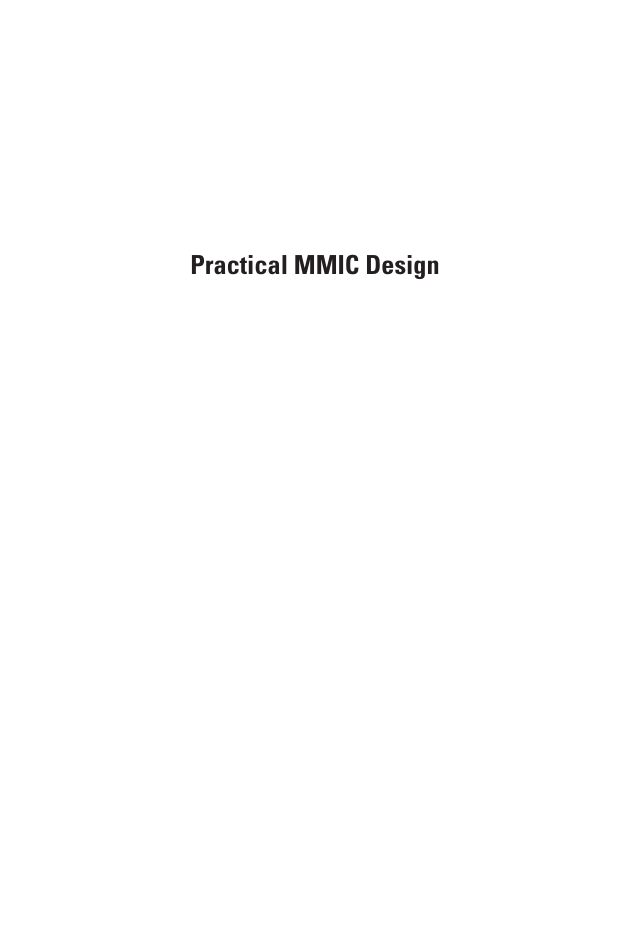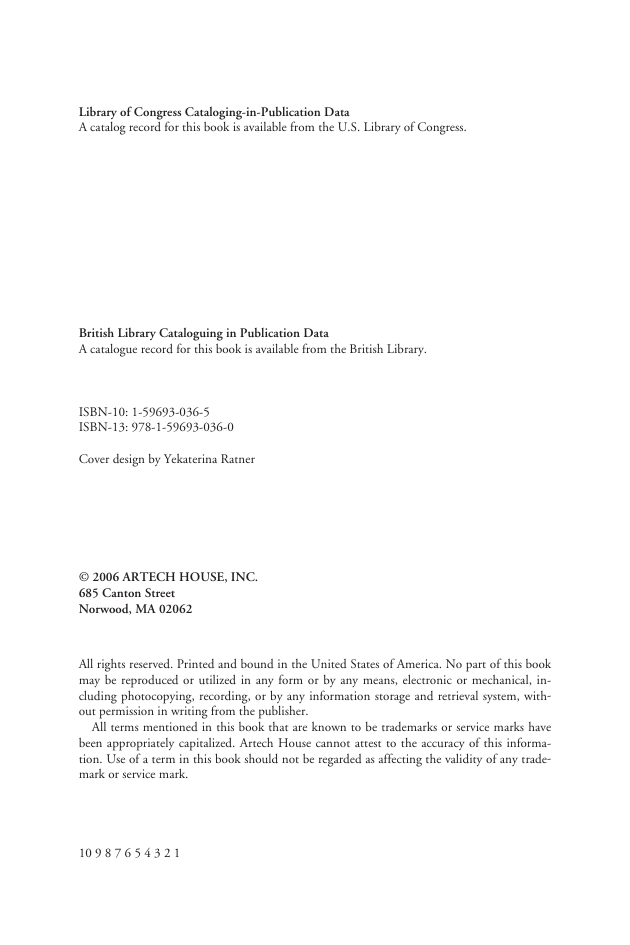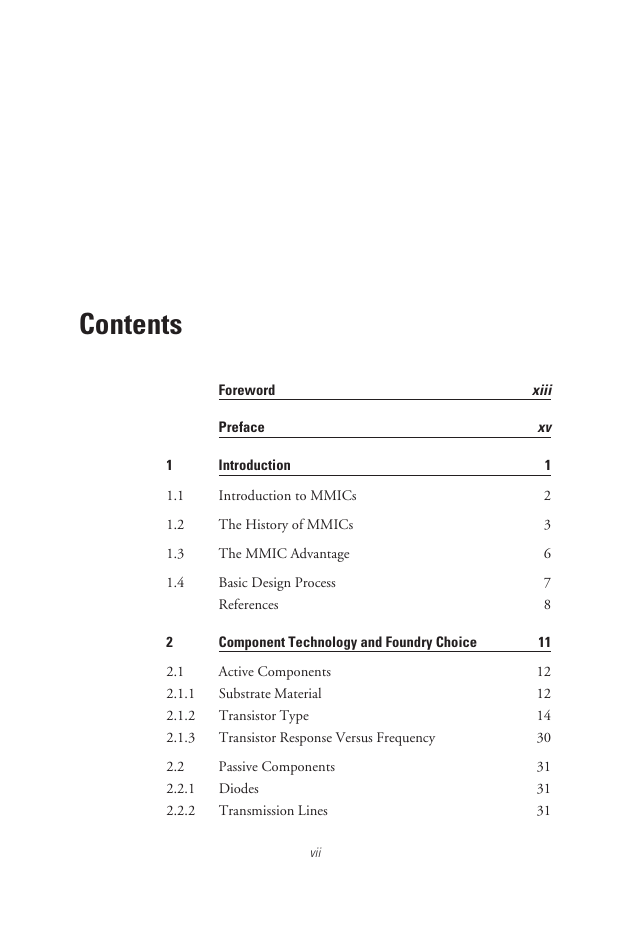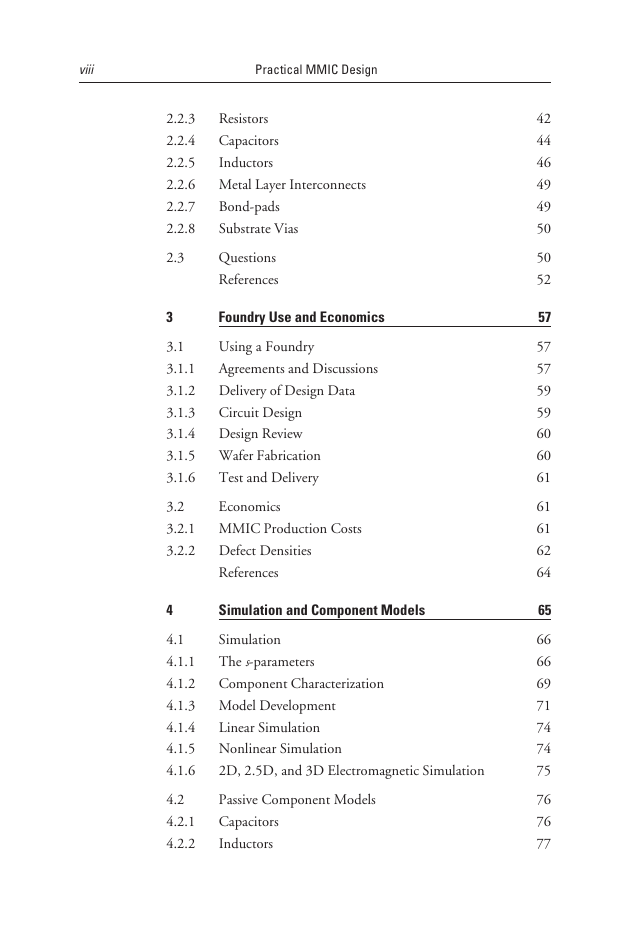Practical MMIC Design
Contents vii
Foreword
Preface xv
1 Introduction 1
1.1 Introduction to MMICs 2
1.2 The History of MMICs 3
1.3 The MMIC Advantage 6
1.4 Basic Design Process 7
References 8
2 Component Technology and Foundry Choice 11
2.1 Active Components 12
2.2 Passive Components 31
2.3 Questions 50
References 52
3 Foundry Use and Economics 57
3.1 Using a Foundry 57
3.2 Economics 61
References 64
4 Simulation and Component Models 65
4.1 Simulation 66
4.2 Passive Component Models 76
4.3 Active Component Models 82
4.4 Questions 84
References 85
5 Design 89
5.1 Impedance Matching and the Smith Chart 90
5.2 Passive Elements 108
5.3 Amplifiers 125
5.4 Oscillators 188
5.5 Mixers 194
5.7 Phase Shifters 210
5.8 Switched-Path Attenuators 213
5.9 Circuits with Digital Application 214
5.10 Millimeter-Wave Circuits 216
5.11 Yield Improvement 231
5.12 Questions 246
References 250
6 Layout 261
6.1 Layout Files 262
6.2 Circuit Layout Process 264
6.3 Layout Checking 267
6.4 Chip Arraying 270
6.5 Mask Manufacture 274
6.7 Questions 277
References 277
7 Processing Technology 279
7.1 Substrate Material Growth 280
7.2 Wafer Production 283
7.3 Surface Layers 283
7.4 Photolithography 285
7.5 Wafer Thinning 302
7.6 Through-Substrate Vias 304
7.7 Back-Face Metal 305
7.8 Chip Separation 306
7.9 Quality Assurance 306
7.10 Questions 308
References 309
8 Test 313
8.1 Process Control and Monitoring (PCM) 313
8.2 The dc Test and Stability Problems 314
8.3 RF Testing and Calibration 315
8.4 Questions 319
References 320
Appendix: Answers to Questions 323
Chapter 2 323
Chapter 4 324
Chapter 5 325
Chapter 6 328
Chapter 7 329
Chapter 8 330
Glossary 331
About the Author 341
Index 343
















 2023年江西萍乡中考道德与法治真题及答案.doc
2023年江西萍乡中考道德与法治真题及答案.doc 2012年重庆南川中考生物真题及答案.doc
2012年重庆南川中考生物真题及答案.doc 2013年江西师范大学地理学综合及文艺理论基础考研真题.doc
2013年江西师范大学地理学综合及文艺理论基础考研真题.doc 2020年四川甘孜小升初语文真题及答案I卷.doc
2020年四川甘孜小升初语文真题及答案I卷.doc 2020年注册岩土工程师专业基础考试真题及答案.doc
2020年注册岩土工程师专业基础考试真题及答案.doc 2023-2024学年福建省厦门市九年级上学期数学月考试题及答案.doc
2023-2024学年福建省厦门市九年级上学期数学月考试题及答案.doc 2021-2022学年辽宁省沈阳市大东区九年级上学期语文期末试题及答案.doc
2021-2022学年辽宁省沈阳市大东区九年级上学期语文期末试题及答案.doc 2022-2023学年北京东城区初三第一学期物理期末试卷及答案.doc
2022-2023学年北京东城区初三第一学期物理期末试卷及答案.doc 2018上半年江西教师资格初中地理学科知识与教学能力真题及答案.doc
2018上半年江西教师资格初中地理学科知识与教学能力真题及答案.doc 2012年河北国家公务员申论考试真题及答案-省级.doc
2012年河北国家公务员申论考试真题及答案-省级.doc 2020-2021学年江苏省扬州市江都区邵樊片九年级上学期数学第一次质量检测试题及答案.doc
2020-2021学年江苏省扬州市江都区邵樊片九年级上学期数学第一次质量检测试题及答案.doc 2022下半年黑龙江教师资格证中学综合素质真题及答案.doc
2022下半年黑龙江教师资格证中学综合素质真题及答案.doc